数据库原理基本概念英文解释
- 格式:docx
- 大小:37.08 KB
- 文档页数:3

数据库英语数据库是现代社会中广泛应用的数据管理系统,由于其在各行各业中的重要性,数据库相关的专业术语在英语中也占据着重要的地位。
本文将介绍数据库中常见的英语术语及其解释,以帮助读者更好地理解数据库领域的知识。
数据库基础1.Database:数据库,是指长期储存在计算机中,有组织、永久存储的数据集合。
它通常受到数据库管理系统(DBMS)的管理。
2.Table:表,数据库中的基本组成单位,用来存储特定类型的数据。
表由行和列组成,每行代表一个记录,每列代表一个字段。
3.Record:记录,表中的一行数据,包含了一组相关的数据。
4.Field:字段,表中的一个列,代表一个数据项或属性。
数据库查询1.Query:查询,是指根据特定条件从数据库中检索所需信息的操作。
2.Select:选择,查询语句中的关键字之一,用于选择需要检索的字段。
3.Where:条件,查询语句中的关键字之一,用于指定检索的条件。
4.Join:连接,用于将两个或多个表中相关字段的数据关联起来。
数据库管理1.DBMS:数据库管理系统,是指用来管理数据库的软件系统,负责数据的存储、检索、更新和管理。
2.SQL:结构化查询语言,是一种用于与关系型数据库通信的标准语言。
3.Index:索引,用于提高数据库查询效率的数据结构,通常基于一个或多个字段创建索引。
4.Backup:备份,是指对数据库中的数据进行定期复制和存档,以防止数据丢失。
数据库安全1.Security:安全性,数据库安全性是指保护数据库不受未经授权的访问、破坏和泄露的措施。
er:用户,数据库中被授权访问和操作数据库的个体或实体。
3.Permission:权限,用来控制用户对数据库对象的访问和操作权限的设置。
4.Encryption:加密,是指对数据库中的敏感数据进行转换,以保护数据的安全性。
数据库发展趋势1.Big Data:大数据,指的是规模巨大、种类繁多的数据集合,对传统数据库系统的处理能力提出了挑战。
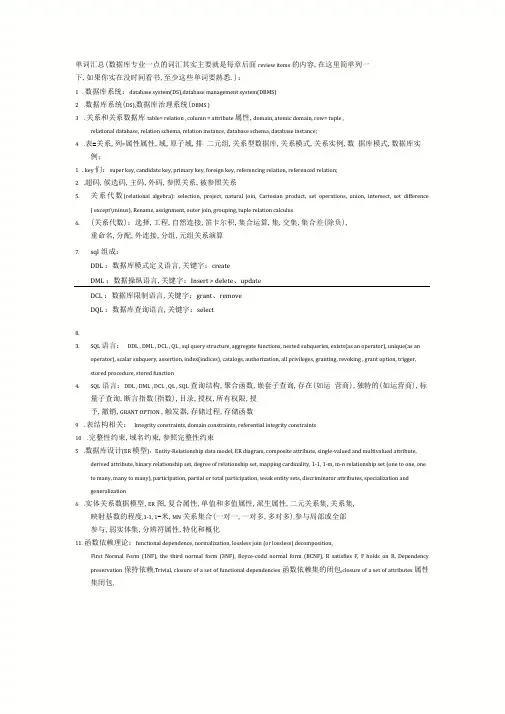
单词汇总(数据库专业一点的词汇其实主要就是每章后面review items的内容,在这里简单列一下,如果你实在没时间看书,至少这些单词要熟悉.):1. 数据库系统:database system(DS),database management system(DBMS)2.数据库系统(DS),数据库治理系统(DBMS )3. 关系和关系数据库table= relation , column = attribute 属性,domain, atomic domain, row= tuple ,relational database, relation schema, relation instance, database schema, database instance;4.表=关系,列=属性属性,域,原子域,排二元组,关系型数据库,关系模式,关系实例,数据库模式,数据库实例;1. key 们:super key, candidate key, primary key, foreign key, referencing relation, referenced relation;2.超码,候选码,主码,外码,参照关系,被参照关系5.关系代数(relational algebra): selection, project, natural join, Cartesian product, set operations, union, intersect, set difference( except\minus), Rename, assignment, outer join, grouping, tuple relation calculus6.(关系代数):选择,工程,自然连接,笛卡尔积,集合运算,集,交集,集合差(除负),重命名,分配,外连接,分组,元组关系演算7.sql组成:DDL :数据库模式定义语言,关键字:createDML :数据操纵语言,关键字:Insert > delete、updateDCL :数据库限制语言,关键字:grant、removeDQL :数据库查询语言,关键字:select8.3.SQL 语言:DDL , DML , DCL , QL , sql query structure, aggregate functions, nested subqueries, exists(as an operator), unique(as anoperator), scalar subquery, assertion, index(indices), catalogs, authorization, all privileges, granting, revoking , grant option, trigger, stored procedure, stored function4.SQL语言:DDL , DML , DCL , QL , SQL查询结构,聚合函数,嵌套子查询,存在(如运营商),独特的(如运营商),标量子查询,断言指数(指数),目录,授权,所有权限,授予,撤销,GRANT OPTION ,触发器,存储过程,存储函数9. 表结构相关:Integrity constraints, domain constraints, referential integrity constraints10.完整性约束,域名约束,参照完整性约束5.数据库设计(ER 模型):Entity-Relationship data model, ER diagram, composite attribute, single-valued and multivalued attribute,derived attribute, binary relationship set, degree of relationship set, mapping cardinality, 1-1, 1-m, m-n relationship set (one to one, one to many, many to many), participation, partial or total participation, weak entity sets, discriminator attributes, specialization and generalization6.实体关系数据模型,ER图,复合属性,单值和多值属性,派生属性,二元关系集,关系集,映射基数的程度,1-1, 1-米,MN关系集合(一对一,一对多,多对多),参与局部或全部参与,弱实体集,分辨符属性,特化和概化11. 函数依赖理论:functional dependence, normalization, lossless join (or lossless) decomposition,First Normal Form (1NF), the third normal form (3NF), Boyce-codd normal form (BCNF), R satisfies F, F holds on R, Dependency preservation 保持依赖,Trivial, closure of a set of functional dependencies 函数依赖集的闭包,closure of a set of attributes 属性集闭包,Armstrong 's axioms Armstrong 公理,reflexivity rule 自反律,augmentation rule,增广率, transitivity 传递律,restriction of F to R i F 在Ri 上的限定,canonical cover 正那么覆盖, extraneous attributes 无关属性,decomposition algorithm 分解算法.7.函数依赖,标准化,无损连接〔或无损〕分解,第一范式〔1NF〕,第三范式〔3NF〕 BC范式〔BCNF〕, R满足F, F持有R,依赖保存,平凡,一组函数依赖封闭,一组属性,8. 事务:transition, ACID properties ACID特性,并发限制系统concurrency control system,故障恢复系统recovery system,事务状态transition state,活动的active,局部提交的partiallycommitted,失败的failed,中止的aborted,提交的committed,已结束的terminated,调度schedule,操作冲突conflict of operations, 冲突等价conflict equivalence,冲突可串彳f化conflictserializablity ,可串行化顺序serializablity order,联级回滚cascading rollback,封锁协议lockingprotocol ,共享〔S〕锁shared-mode lock 〔S-lock〕,排他〔X〕锁exclusive -mode lock 〔X-lock〕, 相容卜i compatibility,两阶段封锁协议2-phase locking protocol,意向锁intention lock,时间戳timestamp, 恢复机制recovery scheme,日志log, 基于日志的恢复log-based recovery, 延迟的修改deferredmodification,立即的修改immediate modification,检查点checkpoint.数据库系统DBS Database System数据库系统应用Database system applications文件处理系统file-processing system数据不一致性data inconsistency——致性约束consistency constraint数据抽象Data Abstraction实例instance模式schema物理模式physical schema逻辑模式logical schema物理数据独立性physical data independence数据方^型data model实体-联系模型entity-relationship model 〔E-R〕关系数据模型relational data model基于对象的数据模型object-based data model半结构化数据模型semistructured data model数据库语言database language数据定义语言data-definition language数据操纵语言data-manipulation language查询语言query language元数据metadata应用程序application program标准化normalization数据字典data dictionary存储治理器storage manager查询治理器query processor事务transaction原子性atomicity故障恢复failure recovery并发限制concurrency-control两层和三层数据库体系结构two-tier/three-tier数据才2掘data mining数据库治理员DBA database administrator表table关系relation元组tuple空值null value数据库模式database schema数据库实例database instance关系模式relation schema关系实例relation instance码keys超码super key候选码candidate key主码primary key外码foreign key参照关系referencing relation被参照关系referenced relation属性attribute域domain原子域atomic domain参照完整性约束referential integrity constraint模式图schema diagram查询语言query language过程化语言procedural language非过程化语言nonprocedural language关系运算operations on relations选择元组selection of tuples选择属性selection of attributes自然连接natural join笛卡尔积Cartesian product集合运算set operations关系代数relational algebraSQL 查询语言SQL query structureSelect 字句select clauseFrom 字句from clauseWhere 字句where clause自然连接运算natural join operationAs 字句as clauseOrder by 字句order by clause相关名称 (相关变量,元组变量) correlation name (correlation variable , tuple variable ) 集合运算set operationsUnionInterestExcept空值null values真值"unknown " truth “ unknown 〞聚集函数aggregate functionsavg, min, max, sum, countgroup byhaving嵌套子查询nested subqueries集合比拟set comparisons{ «,? 二 ,〉〉,?=}{some , all}existsuniquelateral 字句lateral clausewith 字句with clause标量子查询scalar subquery数据库彳修改database modification删除deletion插入insertion更新updating参照完整性referential integrity参照完整T约束referential Hntegrity constraint 或子集依赖subset dependency 可延迟的deferrable断言assertion连接类型join types内连接和夕卜连接inner and outer join左外连接、右外连接和全外连接left、right and full outer joinNatural连接条件、using连接条件和on连接条件natural using and so on 视图定义view definition物化视图materialized views视图更新view update事务transactions提交commit work回滚roll back work原子事务atomic transaction完整性约束integrity constraints域约束domain constraints唯——性约束unique constraintCheck 字句check clause参照完整性referential integrity级联删除cascading delete级联更新cascading updates断言assertions日期和时间类型date and time types默认值default values索弓I index大对象large object用户定义类型user-defined types域domains目录catalogs模式schemas授权authorization权卜M privileges选择select插入insert更新update所有权限all privileges授予权卜M granting of privileges收回权卜M revoking of privileges授予权限的权限privileges to privilegesGrant option角色roles视图授权authorization on views执行授权execute authorization调用者权限invoker privileges行级授权row-level authorizationJDBCODBC预备语句prepared statements 访问元数据accessing metadata SQL 注入SQL injection 嵌入式SQL embedded SQL 游标cursors 可更新的游标updatable cursors 动态SQL dynamic SQL SQL 函数SQL functions 存储过程stored procedures 过程化结构procedural constructs夕卜部语言例程external language routines触发器triggerBefore 和after 触发器before and after triggers过渡变量和过渡表transition variables and tables递归查询recursive queries单调查询monotonic queries排名函数ranking functionsRankDense rankPartition by分窗windowing联机分析处理〔OLAP 〕 online analytical processing多维数据multidimensional data度量属性measure attributes维属性dimension attributes转轴pivoting数据立方体data cube切片和切块slicing and dicing上卷和下钻rollup and drill down交叉表cross-tabulation第七章实体-联系数据模型Entity-relationship data model实体和实体集entity and entity set属性attribute域domain简单和复合属T生simple and composite attributes单值和多值属T生single-valued and multivalued attributes空值null value派生属性derived attribute超码、候选码以及主码super key ,candidate key, and primary key联系和联系集relationship and relationship set二元联系集binary relationship set联系集的度degree of relationship set描述性属性descriptive attributes超码、候选码以及主码super key ,candidate key, and primary key角色role自环联系集recursive relationship setE-R 图E-R diagram映射基数mapping cardinality——对——联系one-to-one relationship——对多联系one-to-many relationship多对——联系many-to-one relationship多对多联系many-to-many relationship参与participation全部参与total participation局部参与partial participation弱实体集和强实体集weak entity sets and strong entity sets分辨符属性discriminator attributes标识联系identifying relationship特化和概化specialization and generalization超类和子类superclass and subclass属性继承attribute inheritance单和多继承single and multiple inheritance条件定义的和用户定义的成员资格condition-defined and userdefined membership 不相交概化和重叠概化disjoint and overlapping generalization全部概化和局部概化total and partial generalization聚集aggregationUMLUML 类图UML class diagram第八章E-R 模型和标准化E-R model and normalization分解decomposition函数依赖functional dependencies无损分解lossless decomposition原子域atomic domains第一范式(1NF) first normal form(1NF)合法关系legal relations超码super keyR 满足 F R satisfies FF在R上成立 F holds on RBoyce-Codd 范式BCNF Boyce-Codd normal form(BCNF)保持依赖dependency preservation第三范式(3NF) third normal form(3NF)平凡的函数依赖thivial functional dependencies函数依赖集的闭包closure of a set of functional dependenciesArmstrong 公理Armstrong s axioms属性集闭包closure of attribute setsF 在Ri 上的限定restriction of F to Ri正贝 1 覆盖canonical cover无关属T生extraneous attributesBCNF 分解算法BCNF decomposition algorithm3NF 分解算法3NF decomposition algorithm多值依赖multivalued dependencies第四范式(4NF) fourth normal form(4NF)多值依赖的限定restriction of a multivalued independency投影-连接范式(PJNF) project-join normal form(PJNF)域-码范式(DKNF ) domain-key normal form(DKNF)泛关系universal relation唯一角色假设unique-role assumption 去标准化denormalization。

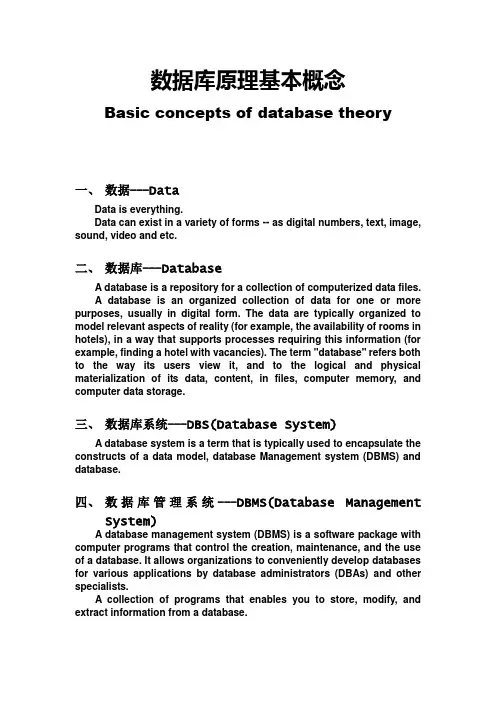
数据库原理基本概念Basic concepts of database theory一、数据---DataData is everything.Data can exist in a variety of forms -- as digital numbers, text, image, sound, video and etc.二、数据库---DatabaseA database is a repository for a collection of computerized data files.A database is an organized collection of data for one or more purposes, usually in digital form. The data are typically organized to model relevant aspects of reality (for example, the availability of rooms in hotels), in a way that supports processes requiring this information (for example, finding a hotel with vacancies). The term "database" refers both to the way its users view it, and to the logical and physical materialization of its data, content, in files, computer memory, and computer data storage.三、数据库系统---DBS(Database System)A database system is a term that is typically used to encapsulate the constructs of a data model, database Management system (DBMS) and database.四、数据库管理系统---DBMS(Database ManagementSystem)A database management system (DBMS) is a software package with computer programs that control the creation, maintenance, and the use of a database. It allows organizations to conveniently develop databases for various applications by database administrators (DBAs) and other specialists.A collection of programs that enables you to store, modify, and extract information from a database.五、数据库管理员---DBA(Database Administrator)A database administrator is a person responsible for the design, implementation, maintenance and repair of an organization's database.六、模式---SchemaA database schema of a database system is its structure described in a formal language supported by the database management system (DBMS) and refers to the organization of data to create a blueprint of how a database will be constructed.In other words, schema is the structure of the database that defines the objects in the database.七、内模式---Internal SchemaInternal Schema: storage schema– Describes how data is stored and what the physical structureof data is.– Totally dependent on particular implementation.– There is only one internal schema in a DB.八、外模式---External SchemaExternal Schema: user schema or subschema– Interface between users and DBS– Describes the logical structure of some local data oriented tosome applications and users– There may be many external schemata in a DB.九、三级模式---Three Levels of Schema-Physical level: describes how a record (e.g., customer) is stored.-Logical level: describes data stored in database, and therelationships among the data.-View level: application programs hide details of data types. Views can also hide information (such as an e mployee’s salary)for security purposes.十、映像---MappingData mapping is the process of creating data element mappings between two distinct data models. Data mapping is used as a first step for a wide variety of data integration tasks including:●Data transformation or data mediation between a data source anda destination●Identification of data relationships as part of data lineageanalysis●Discovery of hidden sensitive data such as the last four digitssocial security number hidden in another user id as part of a datamasking or de-identification project●Consolidation of multiple databases into a single data base andidentifying redundant columns of data for consolidation orelimination十一、逻辑独立性---Logical Independence When schema changes (e.g., new relation/new attribute added), DBA changes the Ex-schema/schema mapping, so the external schema can stay unchanged, i.e. applications needn’t be changed.十二、物理独立性---Physical Independence When internal schema changes ,DBA changes the schema/internal schema mapping, so the schema can stay unchanged . Thus, the external schema also keeps the same.十三、数据模型---Data ModelA data model in software engineering is an abstract model, that documents and organizes the business data for communication between team members and is used as a plan for developing applications, specifically how data is stored and accessed.A data model can be sometimes referred to as a data structure, especially in the context of programming languages. Data models are often complemented by function models, especially in the context of enterprise models.。
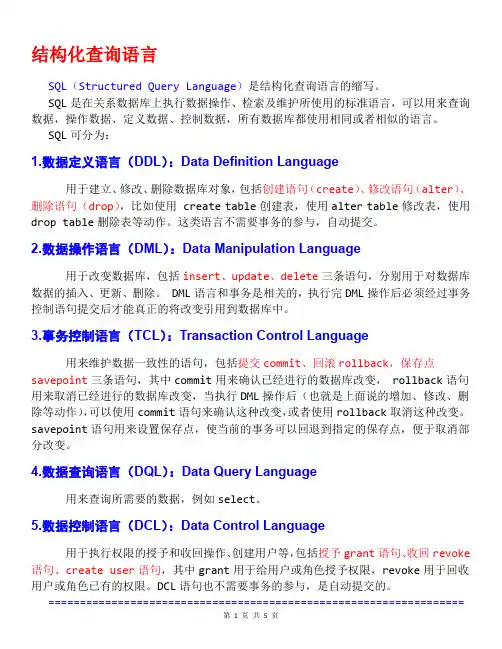
结构化查询语言SQL(Structured Query Language)是结构化查询语言的缩写。
SQL是在关系数据库上执行数据操作、检索及维护所使用的标准语言,可以用来查询数据,操作数据、定义数据、控制数据,所有数据库都使用相同或者相似的语言。
SQL可分为:1.数据定义语言(DDL):Data Definition Language用于建立、修改、删除数据库对象,包括创建语句(create)、修改语句(alter)、删除语句(drop),比如使用 create table创建表,使用alter table修改表,使用drop table删除表等动作。
这类语言不需要事务的参与,自动提交。
2.数据操作语言(DML):Data Manipulation Language用于改变数据库,包括insert、update、delete三条语句,分别用于对数据库数据的插入、更新、删除。
DML语言和事务是相关的,执行完DML操作后必须经过事务控制语句提交后才能真正的将改变引用到数据库中。
3.事务控制语言(TCL):Transaction Control Language用来维护数据一致性的语句,包括提交commit、回滚rollback,保存点savepoint三条语句,其中commit用来确认已经进行的数据库改变, rollback语句用来取消已经进行的数据库改变,当执行DML操作后(也就是上面说的增加、修改、删除等动作),可以使用commit语句来确认这种改变,或者使用rollback取消这种改变。
savepoint语句用来设置保存点,使当前的事务可以回退到指定的保存点,便于取消部分改变。
4.数据查询语言(DQL):Data Query Language用来查询所需要的数据,例如select。
5.数据控制语言(DCL):Data Control Language用于执行权限的授予和收回操作、创建用户等,包括授予grant语句、收回revoke 语句、create user语句,其中grant用于给用户或角色授予权限,revoke用于回收用户或角色已有的权限。
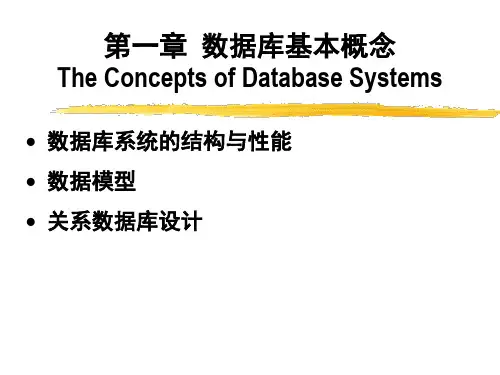
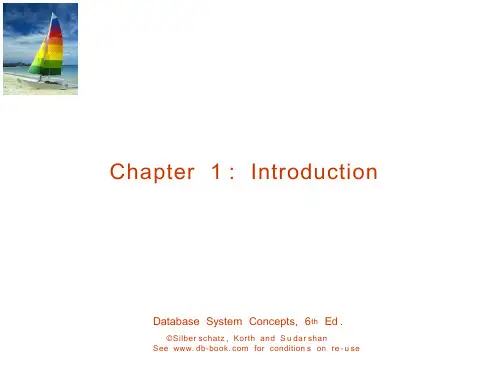
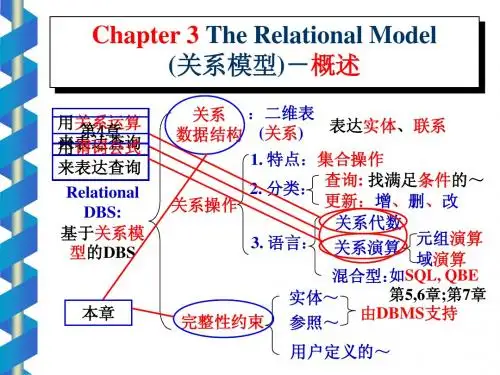
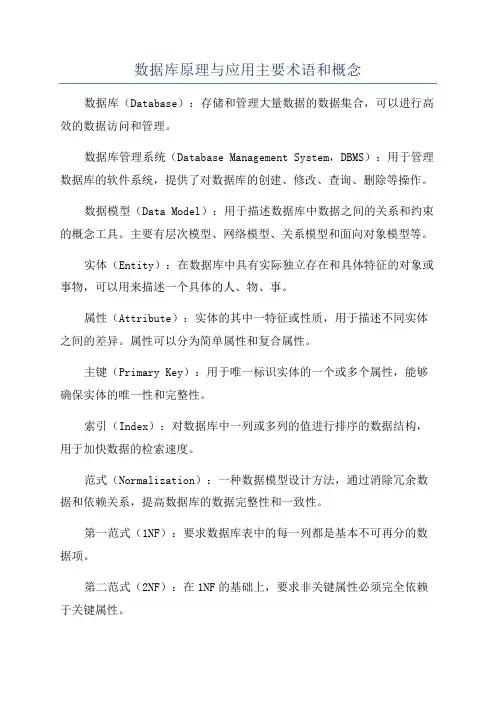
数据库原理与应用主要术语和概念数据库(Database):存储和管理大量数据的数据集合,可以进行高效的数据访问和管理。
数据库管理系统(Database Management System,DBMS):用于管理数据库的软件系统,提供了对数据库的创建、修改、查询、删除等操作。
数据模型(Data Model):用于描述数据库中数据之间的关系和约束的概念工具。
主要有层次模型、网络模型、关系模型和面向对象模型等。
实体(Entity):在数据库中具有实际独立存在和具体特征的对象或事物,可以用来描述一个具体的人、物、事。
属性(Attribute):实体的其中一特征或性质,用于描述不同实体之间的差异。
属性可以分为简单属性和复合属性。
主键(Primary Key):用于唯一标识实体的一个或多个属性,能够确保实体的唯一性和完整性。
索引(Index):对数据库中一列或多列的值进行排序的数据结构,用于加快数据的检索速度。
范式(Normalization):一种数据模型设计方法,通过消除冗余数据和依赖关系,提高数据库的数据完整性和一致性。
第一范式(1NF):要求数据库表中的每一列都是基本不可再分的数据项。
第二范式(2NF):在1NF的基础上,要求非关键属性必须完全依赖于关键属性。
第三范式(3NF):在2NF的基础上,要求非关键属性不能存在传递依赖关系。
数据完整性(Data Integrity):保证数据的准确性和一致性的原则和约束。
事务(Transaction):数据库管理系统中的基本操作单位,具有原子性、一致性、隔离性和持久性等特性。
并发控制(Concurrency Control):保证多个用户并发访问数据库时不会产生数据不一致的机制。
ACID特性:指事务的原子性(Atomicity)、一致性(Consistency)、隔离性(Isolation)和持久性(Durability)。
数据库备份与恢复(Database Backup and Recovery):定期将数据库的数据和结构拷贝到外部存储介质以防止数据丢失,并在需要时将备份的数据恢复到数据库中。
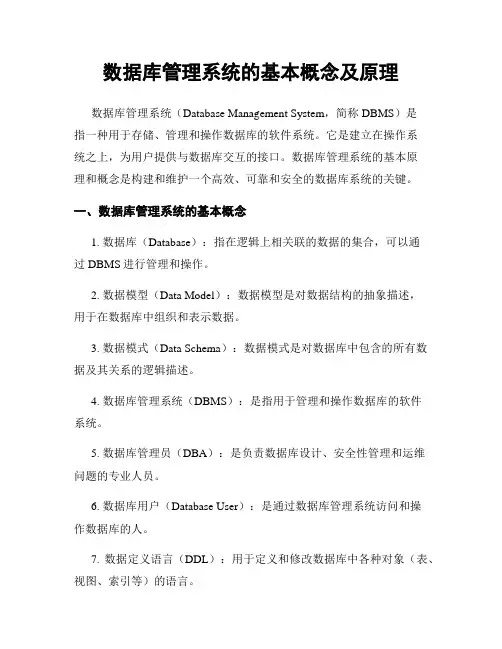
数据库管理系统的基本概念及原理数据库管理系统(Database Management System,简称DBMS)是指一种用于存储、管理和操作数据库的软件系统。
它是建立在操作系统之上,为用户提供与数据库交互的接口。
数据库管理系统的基本原理和概念是构建和维护一个高效、可靠和安全的数据库系统的关键。
一、数据库管理系统的基本概念1. 数据库(Database):指在逻辑上相关联的数据的集合,可以通过DBMS进行管理和操作。
2. 数据模型(Data Model):数据模型是对数据结构的抽象描述,用于在数据库中组织和表示数据。
3. 数据模式(Data Schema):数据模式是对数据库中包含的所有数据及其关系的逻辑描述。
4. 数据库管理系统(DBMS):是指用于管理和操作数据库的软件系统。
5. 数据库管理员(DBA):是负责数据库设计、安全性管理和运维问题的专业人员。
6. 数据库用户(Database User):是通过数据库管理系统访问和操作数据库的人。
7. 数据定义语言(DDL):用于定义和修改数据库中各种对象(表、视图、索引等)的语言。
8. 数据操作语言(DML):用于对数据库进行查询、更新、插入和删除数据的语言。
9. 事务(Transaction):是指由一系列操作组成的逻辑工作单元,具有原子性、一致性、隔离性和持久性等特性。
二、数据库管理系统的基本原理1. 数据的存储和组织:DBMS负责对数据进行组织、存储和管理。
常见的数据组织方式有层次模型、网络模型、关系模型等。
其中,关系模型是最广泛应用的数据模型,通过将数据表示为关系表的形式,实现了数据的简洁和灵活管理。
2. 数据的一致性和完整性:DBMS通过设置各种约束条件(如主键、外键、唯一性约束等),确保数据库中的数据具有一定的一致性和完整性。
这些约束条件能够防止无效、冲突或不符合逻辑的数据进入数据库。
3. 数据的安全性和权限控制:DBMS通过用户认证和授权机制,确保只有授权的用户才能访问和操作数据库。

数据库管理系统的基本概念与原理随着信息技术的高速发展,各种应用系统所涉及的数据量越来越庞大,对数据的管理与处理要求也越来越高。
数据库管理系统(Database Management System,DBMS)因此应运而生,成为目前数据管理和信息处理领域中最有影响力的软件平台之一。
本文旨在介绍数据库管理系统的基本概念与原理。
一、数据库管理系统的定义与分类1. 定义:数据库管理系统是一种可以创建和管理数据库的软件系统。
它是一个数据库的抽象层,用于控制数据库的访问和操作,同时提供数据的安全性和完整性保障。
2. 分类:数据库管理系统按照其应用领域和数据类型可以分为关系型数据库和非关系型数据库两大类。
(1)关系型数据库:一种按照数据表、数据行和数据列的方式存储数据的数据库,常用代表是Oracle、MySQL、SQL Server等。
(2)非关系型数据库:一种按照数据文档和键值对的方式存储数据的数据库,常用代表是MongoDB、Redis、Cassandra等。
二、数据库管理系统的基本原理1. 数据库管理系统的架构数据库管理系统有三层架构,从下到上分别是存储层、管理层和应用层。
(1)存储层:主要负责数据的物理存储和管理;(2)管理层:主要负责数据的逻辑管理和访问控制;(3)应用层:提供各种应用程序接口(API),使用户可对数据库进行增、删、改、查等操作。
2. 数据库管理系统的基本操作数据库管理系统有四种基本操作,即增、删、改、查(CRUD)。
(1)增:即插入数据,可通过SQL语言(Structured Query Language)进行添加。
(2)删:即删除数据,可通过SQL语言进行删除。
(3)改:即更新数据,可通过SQL语言进行修改。
(4)查:即查询数据,可通过SQL语言进行查询。
3. 数据库管理系统的特性数据库管理系统有五个基本特性,分别是原子性、一致性、隔离性、持久性和高可用性。
(1)原子性:即事务的原子性,是指事务中的所有操作都要么全部完成,要么全部失败回滚。
数据库原理英文Database PrinciplesIntroduction:Database principles are fundamental concepts that govern the design, management, and use of databases. A database is a structured collection of data that is organized and stored in a manner that allows for efficient retrieval, manipulation, and analysis.Data Models:Data models are used to represent how data is organized and structured within a database. These models determine the relationships between data elements and define the rules for how data is stored and manipulated. Common data models include hierarchical, network, relational, and object-oriented.Relational Model:The relational model is the most widely used data model in modern databases. It organizes data into relations, which are tables with rows and columns. Each row represents a record, and each column represents a characteristic or attribute of that record. Relationships between tables are established through primary keys and foreign keys.Normalization:Normalization is the process of designing database tables to reduce redundancy and improve data integrity. It involves breaking down large tables into smaller ones and creating relationships between them. The goal is to eliminate data anomalies and ensure that eachpiece of data is stored in one place only.Query Languages:Query languages allow users to retrieve, manipulate, and update data in a database. The most common query language is Structured Query Language (SQL), which is used to interact with relational databases. SQL provides a set of commands and functions that enable users to perform operations such as data retrieval, insertion, deletion, and modification.Indexing and Query Optimization:Indexes are data structures that improve the speed of data retrieval operations. They provide a way to locate data quickly based on specific criteria. Query optimization involves analyzing and rearranging queries to execute them in the most efficient way possible. Techniques such as storing intermediate results, using parallel processing, and selecting appropriate indexing strategies are commonly employed.Transaction Management:A transaction is a unit of work that consists of one or more operations performed on a database. Transaction management ensures the atomicity, consistency, isolation, and durability of database operations. Transactions are usually managed by a database management system (DBMS) through the use of transaction logs and concurrency control mechanisms. Concurrency Control:Concurrency control prevents conflicts when multiple users try to access or modify the same data simultaneously. Techniques suchas locking, timestamping, and optimistic concurrency control are used to manage concurrent access and ensure data consistency. Backup and Recovery:Backup and recovery involve creating copies of a database to protect against data loss and ensuring that data can be restored in the event of a failure. Backups can be performed at different levels (database, table, or file) and can be either full or incremental. Recovery mechanisms restore the database to a consistent state after a failure, using backup copies and transaction logs. Conclusion:Understanding database principles is essential for designing efficient and robust databases. Data modeling, normalization, query languages, indexing, transaction management, concurrency control, and backup and recovery are key concepts that form the foundation of database systems. By applying these principles, database professionals can optimize data storage, retrieval, and manipulation, leading to better performance and data integrity.。
什么叫数据库的原理和应用1. 数据库的原理数据库是指将数据按照一定的数据模型组织、存储和管理的一种数据集合。
数据库的原理包括数据的组织方式、数据的存储结构以及数据的访问和管理方式。
以下是数据库的原理:•数据模型:数据库使用不同的数据模型来描述数据的结构和关系。
常见的数据模型有层次模型、网状模型和关系模型。
关系模型是目前应用最广泛的数据模型,它使用表格来表示数据的结构和关系,为数据的管理和查询提供了方便。
•数据库管理系统(Database Management System,DBMS):DBMS 是用来管理数据库的软件,它提供了对数据库的定义、存储、查询、更新和控制等功能。
DBMS通过使用数据定义语言(Data Definition Language,DDL)、数据操纵语言(Data Manipulation Language,DML)和数据控制语言(Data Control Language,DCL)来实现对数据库的操作和管理。
•数据库的存储结构:数据库的存储结构包括表、记录和字段。
表是用来存储数据的数据结构,记录是表中的一行数据,字段是记录中的一个数据项。
数据库使用表来组织和存储数据,通过记录和字段来描述数据的结构和属性。
•数据的关系:数据库中的数据可以通过关系来建立联系。
关系可以通过主键和外键来表示,主键是用来唯一标识记录的字段,外键是用来与其他表建立关联的字段。
通过建立关系,数据库可以实现数据的一致性和完整性。
2. 数据库的应用数据库在各行各业都有广泛的应用,以下是数据库的常见应用场景:•企业信息管理:数据库可以用来存储和管理企业的各种信息,例如员工信息、客户信息、产品信息等。
通过数据库,企业可以实现对信息的集中管理和快速检索,提高信息管理的效率和准确性。
•网络应用:数据库在互联网应用中起着重要的作用。
例如,电子商务网站可以使用数据库存储商品信息、用户信息等,实现在线购物和订单管理。
社交网络平台可以使用数据库存储用户信息、关系信息等,实现用户的注册、登录和社交功能。
数据库系统概述一、有关概念四个基本概念1.数据(Data):数据库中存储的基本对象2.数据库的定义:数据库(Database,简称DB)是长期储存在计算机内、有组织的、可共享的大量数据集合3.数据库管理系统(简称DBMS):位于用户与操作系统之间的一层数据管理软件(系统软件)。
用途:科学地组织和存储数据;高效地获取和维护数据主要功能:1.数据定义功能 2.数据操作功能 3.数据库的事务管理和运行管理功能4.数据库的建立和维护功能5.数据的组织,存储和管理功能6.其他功能4.数据库系统(Database System,简称DBS):指在计算机系统中引入数据库后的系统桌面DBMS Access ,VFP客户机/服务器型DBMS SQL Server , Oracle, MySQL , DB25.数据库系统(DBS)的构成数据库数据库管理系统(及其开发工具)应用系统数据库管理员(DBA)和用户二、数据管理技术的发展1.数据管理的三个阶段人工管理阶段文件系统阶段数据库系统阶段2数据库系统管理数据的特点如下1数据共享性高、冗余少; 2 数据结构化;3 数据独立性高;4由DBMS进行统一的数据控制功能3.数据库管理系统的主要功能1数据定义功能2数据操作功能3数据库的事务管理和运行管理功能4数据库的建立和维护功能5数据的组织,存储和管理功能6其他功能4.DBMS 可以对数据提供哪些控制功能?数据的安全性(Security)保护:保护数据,以防止不合法的使用造成的数据的泄密和破坏。
数据的完整性(Integrity)检查:将数据控制在有效的范围内,或保证数据之间满足一定的关系。
并发(Concurrency)控制:对多用户的并发操作加以控制和协调,防止相互干扰而得到错误的结果。
数据库恢复(Recovery):将数据库从错误状态恢复到某一已知的正确状态。
数据模型用来抽象、表示和处理现实世界中的数据和信息的工具。
通俗地讲数据模型就是数据结构:是所研究的对象类型的集合,它是刻画一个数据模型性质最重要的方面;数据结构是对系统静态特性的描述数据操作:对数据库中数据允许执行的操作及有关的操作规则;对数据库中数据的操作主要有查询和更改(包括插入、修改、删除);数据操作是对系统动态特性的描述数据的约束条件:数据及其联系应该满足的条件限制概念模型一、模型的三个世界1.现实世界2.信息世界:即根据需求分析画概念模型(即E-R图),E-R图与DBMS无关。
数据库原理基本概念英文解释
Database principles refer to the fundamental concepts that define the structure, functionality, and management of a
database system. These principles are essential for designing, implementing, and maintaining a reliable and efficient database. In this essay, I will discuss the basic concepts and principles
of databases in detail, including data modeling, data integrity, normalization, indexing, and database transactions.
Data Modeling:
Data modeling is the process of defining the structure and relationships of the data in a database. It involves identifying and organizing the various entities, attributes, and
relationships that exist within the domain of an application. There are different types of data models, such as the conceptual, logical, and physical data models. The conceptual data model describes the high-level view of the data, the logical data
model represents the data structure using entities, attributes, and relationships, and the physical data model maps the logical data model to a specific database management system.
Data Integrity:
Data integrity ensures the accuracy, consistency, and reliability of data stored in a database. It ensures that the data values conform to defined rules or constraints. There are
four types of data integrity: entity integrity, referential integrity, domain integrity, and user-defined integrity. Entity integrity ensures that each row in a table has a unique identifier. Referential integrity ensures that relationships between tables are maintained. Domain integrity ensures that data values are within certain predefined ranges. User-defined integrity ensures that additional business rules or constraints are enforced.
Normalization:
Normalization is the process of organizing data in a database to reduce redundancy and improve data integrity. It involves breaking down larger tables into smaller, more manageable entities and establishing relationships between them. The normalization process follows a series of normal forms, such as First Normal Form (1NF), Second Normal Form (2NF), Third Normal Form (3NF), etc. Each normal form has a set of rules that need to be satisfied to ensure data integrity and eliminate data anomalies, such as update, insertion, and deletion anomalies.
Indexing:
Indexing is a technique used to improve the efficiency of data retrieval operations in a database. It involves creating an index on one or more columns of a table, which allows the database system to locate specific rows quickly using the indexed column(s). Indexes are typically implemented as B-trees
and provide a faster search mechanism by reducing the number of disk I/O operations required to locate data. Indexes should be carefully designed and maintained to balance the trade-off between query performance and the overhead of maintaining the index.
Database Transactions:。